 Thursday 6/16
Thursday 6/16
Public Art Network Award Presentation
Presented to Barbara Goldstein, author of Public Art By the Book, and works to bring people together creating place through public art.
She highlighted some of her favorite pieces, and noted that our government agenda are the lofty goals of bringing people together, fairness, people – and considers public art a way to do that. Her thoughts:
- From Robert Pena Graham: Public art should be like a library, stimulating thought, full of all sorts of things, some you like, some you don’t.
- Everyone has an opinion. It is good to reply to people “I’m so glad you have an opinion” and then open up a conversation.
- Grow the field
- Learn from mistakes.
She spoke about Subculture Joe and his alteration of Hammering Man by attaching a ball and chain. And then it was given a Santa hat.
Public art should work on different levels for different audiences – she spoke about a collection of bronze circus animals in a park that a person protested because a monkey had a penis. In fact , in the law is something called the Six Reasonable People criteria – if 6 reasonable people find nothing objectionable, then there is no problem.( In fact the real problem was that bronze gets too hot in the sun for the pieces to be left uncovered on sunny days.)
Public Art Tour
Strategies for Survival: Artist Housing and Workspace in Fort Point.
Guided by architect for the project Lajos Heder. The project is a limited equity co-op of 48 artists and 7 businesses, which had the good fortune to purchase the building during a financial crash – which made it affordable.
The Fort Point area has about 300 working artists, they do open studios monthly. The organization works with corporations that are moving in to ensure that workspace remains available, and to help support the artists’ work. Businesses recognize the value of the arts and so far have been cooperative.
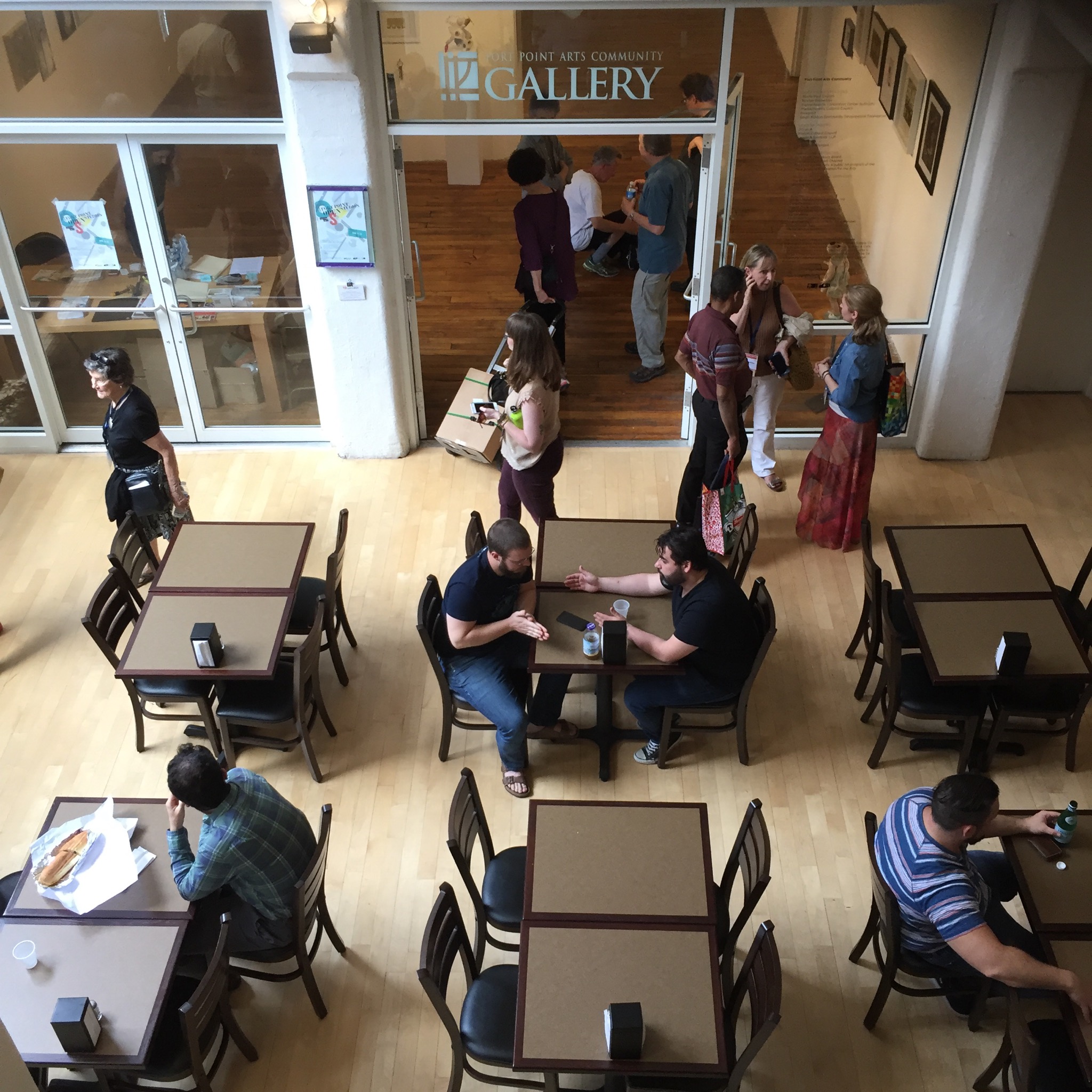 The building includes a 700 sq ft gallery adjacent to a funky little café – the café staff keeps the gallery open during weekends for the artists when staff is not available. The building is operated as a combination of condo and coop.
The building includes a 700 sq ft gallery adjacent to a funky little café – the café staff keeps the gallery open during weekends for the artists when staff is not available. The building is operated as a combination of condo and coop.
 George Fiefeld, Boston Cyber Arts, showed the cyber art marquee at the Massachusetts Convention Center – he teamed traditional artists with cyber artists to create the pieces. Each are paid $500 for their work, which the Center then has rights to.
George Fiefeld, Boston Cyber Arts, showed the cyber art marquee at the Massachusetts Convention Center – he teamed traditional artists with cyber artists to create the pieces. Each are paid $500 for their work, which the Center then has rights to.
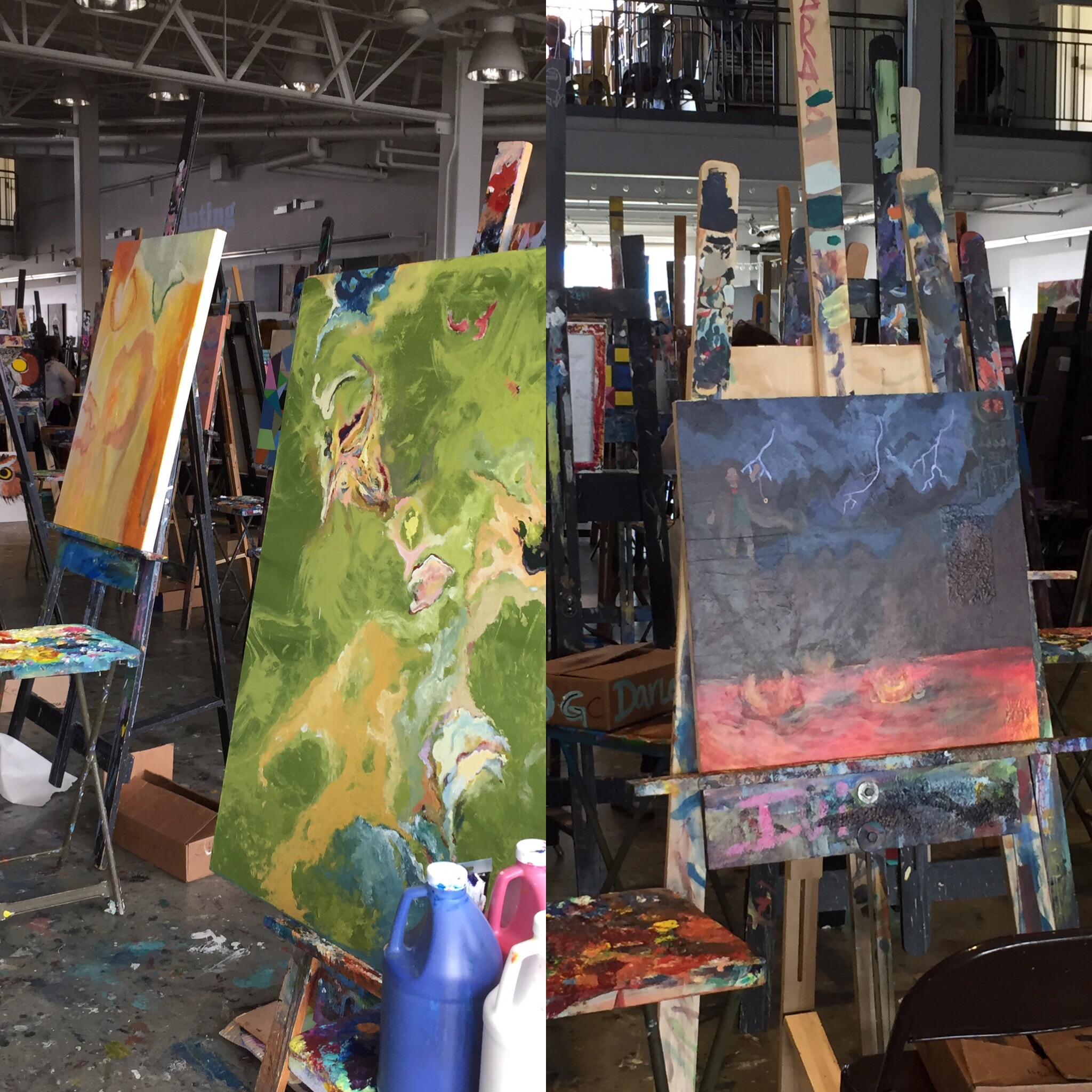 Artists for Humanity, an artist studio that now pays $10/hour for the kids to produce artwork. The pieces sold support the programs. Street kids invited into studio mentored in art and marketing. Basic business protocols. They moved to Fort Point, which felt far away, but the kids kept coming. The program has been going for 25 years. Many graduates come back to teach or mentor. The young people earn respect as well as money. First come first served. They must be In high school with a preference for freshmen or sophomores (more time to train them). In the program, they get college readiness support. $1.5 million in sales of their work. Standard price/size. Once and artists sells work, then their pieces values may rise. 70% of the graduates go into creative careers. Standard 2×2 painting $350
Artists for Humanity, an artist studio that now pays $10/hour for the kids to produce artwork. The pieces sold support the programs. Street kids invited into studio mentored in art and marketing. Basic business protocols. They moved to Fort Point, which felt far away, but the kids kept coming. The program has been going for 25 years. Many graduates come back to teach or mentor. The young people earn respect as well as money. First come first served. They must be In high school with a preference for freshmen or sophomores (more time to train them). In the program, they get college readiness support. $1.5 million in sales of their work. Standard price/size. Once and artists sells work, then their pieces values may rise. 70% of the graduates go into creative careers. Standard 2×2 painting $350
40% of their funding is grants and donations or other funding.
#Afhboston
Building Equitable Communities
- Erin Harkey, Civic Art Project Manager, LA County Arts Commission
- Caroline Vincent, Metro Nashville Arts Commission
- Marcia Iwaskai, Public Art Manager, City of Seattle
- Elisheba Johnson, City of Seattle Office of Cultural Affairs
- Micaela Martegani, MORE ART
Caroline Vincent: Their mission is to drive a vibrant and equitable community through the arts.
- E.A.L. Racial Equity in Arts Leadership
- Artober in Nashville – social media to spotlight things happening all over Nashville. Sort of crowd-noticing.
- Mark A Mark loan program
- Call grants “Community investments” instead of “grants”.
- Artisan manufacturing – working to change zoning to allow art spaces possible. (Tool-Fire)
- Thrive – micro-funding
Marcia and Elisheba: Seattle is the 5th whitest city in the US.
- The city instituted Race and Social Justice initiative to root out institutional policies of injustice. All city employees have to take training.
Seattle Cultural Affairs To Do: Steal all their resources.
- Artists Up: Learning to serve community of color better. Lesson: Don’t lump all races together. Have meetings inviting all Asians, all African Americans, and check in with the meeting customs of those groups for timing, if childcare is needed, etc.
- Ethnic Artist Roster
- Emerging Public Artist Roster – similar to our Teaching Artists Roster. Artists take 8 2-hour classes on topics such as working with architects, and then are eligible for public art project applications – they have small projects that the new grads get to apply for. Focus on equity in engaging artists – open to all but priority is given to underrepresented artists.
- 2015 Boot Camp- 2-day 12/hours/day intense public art training. Provide them with a Public Art Handbook – ‘bible.’ Artists offer 5 tips they wish they had known – best heard from peers.
MORE ARTS Chelsea NY
- “Collective Portraits” by Gary Simmons, 2005
- “Enemy Kitchen” cooked Iraqi food every day for a month with children, and then at the end the children cooked a meal – chose to do American food with Iraqi twist/spices
- 2009 started working with senior citizens
- 2013 “Moon Guardians” photos of former residents projected in the windows of an old derelict building in the neighborhood.
- 2014 looked at homelessness – Created photo portraits of the homeless in the subways, and posted them there. The invisible population of NYC.
- 2016 Month2Month, a project examining housing – a right or a privilege? Is private development the best way to keep NYC viable for all its current and future residents? People invited to a dinner with conversation – had the chance to win an apartment to live in.
- +Art live streamed from 4th Ave subway?
Public Art Network Review
- Criteria:
- Creativity
- Concept
- Innovation
- Responsiveness
- Success
Judges sorted projects into:
- Social Justice
- Environmental
- Performative (temp/movable)
- Historical/Memory
- Technology
- Community Based
- Conventional/Unconventional materials
Perhaps I was biased because they did not select our nomination of the Walter Soboleff Building, although in my opinion it hit all criteria in spades, but I was less impressed with this year’s selections than those in years’ past.
Of note:
National Park Service celebrates its 100th Anniversary this year and will be putting up YouTubes of all of the Arts in the Parks shortly. Constance Baltuck has done a couple of these.
“This Home is Not for Sale” Witt Siasoco and Molly Van Avery – Poetry on real estate for sale signs distributed around Minneapolis. Sort of like Little Free Libraries. We could do this.
I believe that 36 works (out of 200+) were selected. Ones that struck me:
“Murmur Wall” Yerba Buena Center for the Arts.
“Sensing You” lighting in an underpass that responds to motions (Also a similar installation in Boston Fort Point.
“Imagine Art Here: Tyson’s Tiles, Tyson VA, the public responses fed into their master plan.
“Lost and Found” Pittsburgh
“Storefront Theater” an ArtPlace America grant project in Lyons NE. An old storefront opens up at night with theater seating so performances happen in the street.
Friday, 6/17/16 Opening Plenary
- Diane Paulus, The Terrie and Bradley Bloom Artistic Director, American Repertory Theater at Harvard.
- Rise Wilson, Director of Philanthropy, Robert Rauschenberg Foundation
Sponsored by Bank of America –Apply for funding from them! “Don’t meddle, just enable.”
Arts are a record of our best, a manifestation of our gifts that make us human, of the divine in humans.
“Knowledge is limited, imagination encircles the world” Einstein.
BofA is the single largest funder of the arts.
Get Robert Gard’s new book To Change The Face And Heart Of America: Selected Writings on the Arts and Communities 1949-1989
Diane Paulus: ART of Human Rights –
Theater brings us to new worlds and empathy. Converts knowledge to understanding.
Being AWAKE is the radical. She shared a story of a friend of hers actively fighting on behalf of oppressed and disadvantaged women, while ignoring her own body’s need for help as it developed cancer. Pay attention, be awake.
She referenced Zynga platform: How do we use in the internet to democratize the conversation? (https://en.wikipedia.org/wiki/Zynga (My question: Does everyone have access to the internet? If not….)
Fostering Risk to Creatively Solve Stubborn Problems
- Kim Cook, from New Orleans arts, recently joined Burning Man
- Wendy Su, ACLS Public Fellow, LA Dept of Cultural Affairs
- Jonathan Moscone, Director of Civic Engagement, Yerba Buena Center for the Arts
- Liz Powers, Chief Happiness Spreader, Art Lifting
- Kate Dewey, President the Forbes Funds
- Each introduced a focus, and then the group broke the large crowd into small groups by interest, unfortunately hard to hear the conversations the way the room was set up, and the room was quite cold, so not optimal situation.
Kim – listen for visions. Be honest, be true to self.
Wendy: Digital systems for San Francisco Arts. Technology is scary, risky, moves fast, people have a fear of being outpaced, and suffer from information overload. We need to rethink how to be open. We need to foster openness, agility, iterative-ness. 86% of Angelinos are on the internet (did not say how that affects non-Angelinos)
John: Creating prototype solutions for Market Street in the SF. It is important to build relationships and trust through one on one conversations. Understand the systems and relationships in a neighborhood.We may need to change ideas based on the neighborhood feedback.
Liz: ArtLifting is similar to the student art studios in Fort Point, for homeless population. It is not a non-profit nor a for-profit. It is considered a Benefit corporation. Art making to bring the lonely, homeless together in shelters to make and sell art. Creating a national network of all art groups in shelters – now in 11 states.
Kate: Uprise – $1 million to look at how to engage the community with non-profits, using technology?
Taking Action in the Pursuit of Cultural Equity
- Margie Johnson Reese, ED Wichita Falls for Arts and Culture, and AFTA board led the conversation with these as “thought leaders:”
- Ra Joy, ED Change Illinois!
- Maria Lopez de Leon, ED National Association of Latino Arts and Cultures
- Deborah Vaughn, Arts Education Coordinator, Oregon Arts
- Clay Lord, VP Local Arts Advancement, AFTA
And members of the audience.
Introduced the AFTA Cultural Equity Statement. In essence: “Do good” and then asked for thoughts on the new policy.
Ra Joy – Generally we are cowardly in discussions of race.
Maria – Soon, the minority will be the majority, but the structure is institutionalized white. We need conversations – who is missing, what are the next steps.
Deborah- Economic equity is an entry point. Of concern: Facebook algorithms prevent us from hearing voices we don’t want to hear. The AFTA statement is broad and invites people in to the begin the scarier conversations.
Clay – it is guiding but not proscriptive.
Audience:
- It is tiring trying to get the message through.
- Would like to have the statement push a little more.
- Be accountable for intent or outcome.
- From the Very Special Arts perspective equity is what is needed to get over the fence, as opposed to equality, which is giving the same to all regardless of need.
Interesting to consider in Any Given Child?
What are you doing about this?
Deborah – Figured out Poetry Out Loud for the deaf. Asked permission to say the wrong thing.
Check in with Deborah about how to include deaf students in our Poetry Out Loud competitions. Laura Forbes from ASCA is talking with Deborah this week on that topic.
Maria – Launching a pilot intercultural leadership institute.
Ra – Working on statewide political equity in civic engagement, with Mellon and Ford Foundations: Enrich Chicago – diversity, inclusion, equity,.
Watch Angelique Power’s TED Talk (I am unable to find a link to that – found a Vimeo) https://vimeo.com/141286653
Comments:
- Whiteness creates boundaries – white ideology and language present barriers.
- When you are the token black – what to say? We need better benchmarks for equity that better address the problems.
- What about Freelance artists – how are we involving them in solving problems.?
- More diverse genuine friendships. Not just workplace colleagues. Friendship brings understanding and empathy.
- Board development advice: Who are the community leaders? Bring them in.
- Set guidelines: No less that x% of funds need to be allocated to people of color.
Saturday, 6/18 Plenary
Open with women’s drumming group, Genki Spark,
- Donna Brazile, Vice Chair of the Democratic National Committee
- Jane Chu, Chair, NEA
- ViJay Gupta, 1st violin, LA Phil
- Ana Teresa Fernandez, Artist
- Jorge Ferriera, Deputy, Alameda County Sheriff’s Office
- Moderated by Jim Canales, Barr Foundation
I cannot do Donna’ speech justice.
- To Do: Watch the YouTube of the session.
- Note that all the sessions are available on YouTube.
“All art is political” Toni Morrison
Moving comments on the Orlando tragedy. “Can’t Fly, shouldn’t be able to buy.” Doesn’t have anything to do with 2nd amendment. She learned “We will not hate” from her grandmother.
Be informed about political candidates. Read their statements, know their views.
Plant seeds – Her grandmother would quote Galatians 6:9: Let us not become weary in doing good, for at the proper time we will reap a harvest if we do not give up.
Comments that struck me from the other speakers:
Be citizen artists.
Raise awareness. Speak truth to power. Be informed. Music speaks without words. Working with the homeless feeds the orchestra/artist. Be provocateurs, masterful disrupters. Definition makes comfortable. Undefined is scary.
Injure and heal at the same time.
Jorge looked to see that there was a problem but who would step into the gap and replace the problem cops? So he became a sheriff.
Being an artist of color is more pressure.
Think of collateral benefits (the idea of birds on telephone wire – the wire serves two purposes, or dips at corners of sidewalks good for more than just wheelchair bound)
What does classical music say to people in a poor area? Create space for the people to sing back to us.
Put the artists in the institutions.
The lions are coming! Dance like the Maasai to guard against them.
Agency and integrity as wholeness.
ArtVenture Tour #8 The Role of Civic Practice in Social Justice Conversations
Led by Design Studio for Social Intervention
On the tour, we visited
Women Building Boston, a group training low-income women in the building trades and helping them get work, union jobs, which ensures equal pay for women. Woman who told her story – she, her daughter, and granddaughter, had been living in homeless shelter. Now she has work and can provide a home.
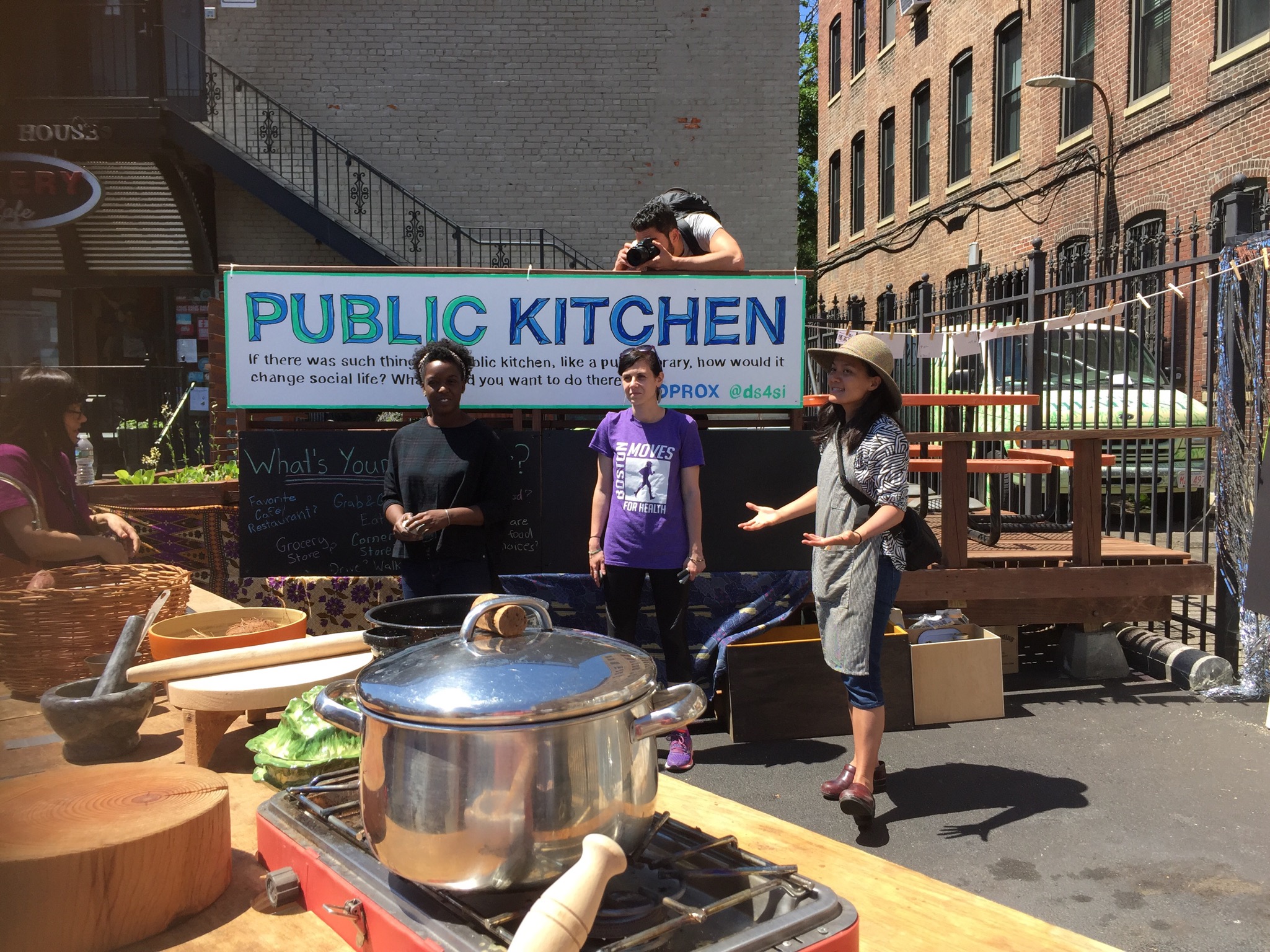 Public Kitchen and a Fresh Food Generation Food Truck. A sort of pop-up installation around the neighborhood that offers lessons, equipment, food for the neighborhood to cook good meals. The Food Truck works with a public garden and has opened a kitchen in a health clinic to help people develop healthy eating habits. The Public Kitchen has been invited to New Zealand and Australia, as well as other parts of the country as a demonstration project.
Public Kitchen and a Fresh Food Generation Food Truck. A sort of pop-up installation around the neighborhood that offers lessons, equipment, food for the neighborhood to cook good meals. The Food Truck works with a public garden and has opened a kitchen in a health clinic to help people develop healthy eating habits. The Public Kitchen has been invited to New Zealand and Australia, as well as other parts of the country as a demonstration project.
- Possibly we could use this idea in Cedar Park and Geneva Woods, in collaboration with the churches that provide food for kids in the summer (Christina Apathy is working for the Northern Light program) and the Food Bank.
 Careforce One, a “superhero” for domestic workers and care givers-, from New York, who tries to help nannies and other domestics know their rights (recently passed laws in NY and MA.)
Careforce One, a “superhero” for domestic workers and care givers-, from New York, who tries to help nannies and other domestics know their rights (recently passed laws in NY and MA.)
And Peep Show, a u-haul truck set up with performances inside the truck visible through little holes in an end cover – dance, theatre – with stories to raise awareness, and crates with a little diorama in them. Careforce one had superhero trading cards with the stories of domestic workers that can be read on smart phone.
- Get her to Juneau for the next ComiCon
 Those artists then met us in a Roxbury neighborhood park, a reclaimed vacant lot, with dancing, drumming, theater, and printmaking. Called PopRox, the goal is to get people out of their homes and meeting one another. The dancers performed in a small grocery store, and then in a small Cape Verde café. The choreographer said about the café piece that she had observed young men coming into the café hungry and they called the woman who owns/cooks Mom – she realized they were hungry but too proud to go home to ask for food, so they come to this café. #poprox
Those artists then met us in a Roxbury neighborhood park, a reclaimed vacant lot, with dancing, drumming, theater, and printmaking. Called PopRox, the goal is to get people out of their homes and meeting one another. The dancers performed in a small grocery store, and then in a small Cape Verde café. The choreographer said about the café piece that she had observed young men coming into the café hungry and they called the woman who owns/cooks Mom – she realized they were hungry but too proud to go home to ask for food, so they come to this café. #poprox
Look up the LayAr App, and Smart Simple.
Inclusive by Design Concert sponsored by VSA Massechusetts
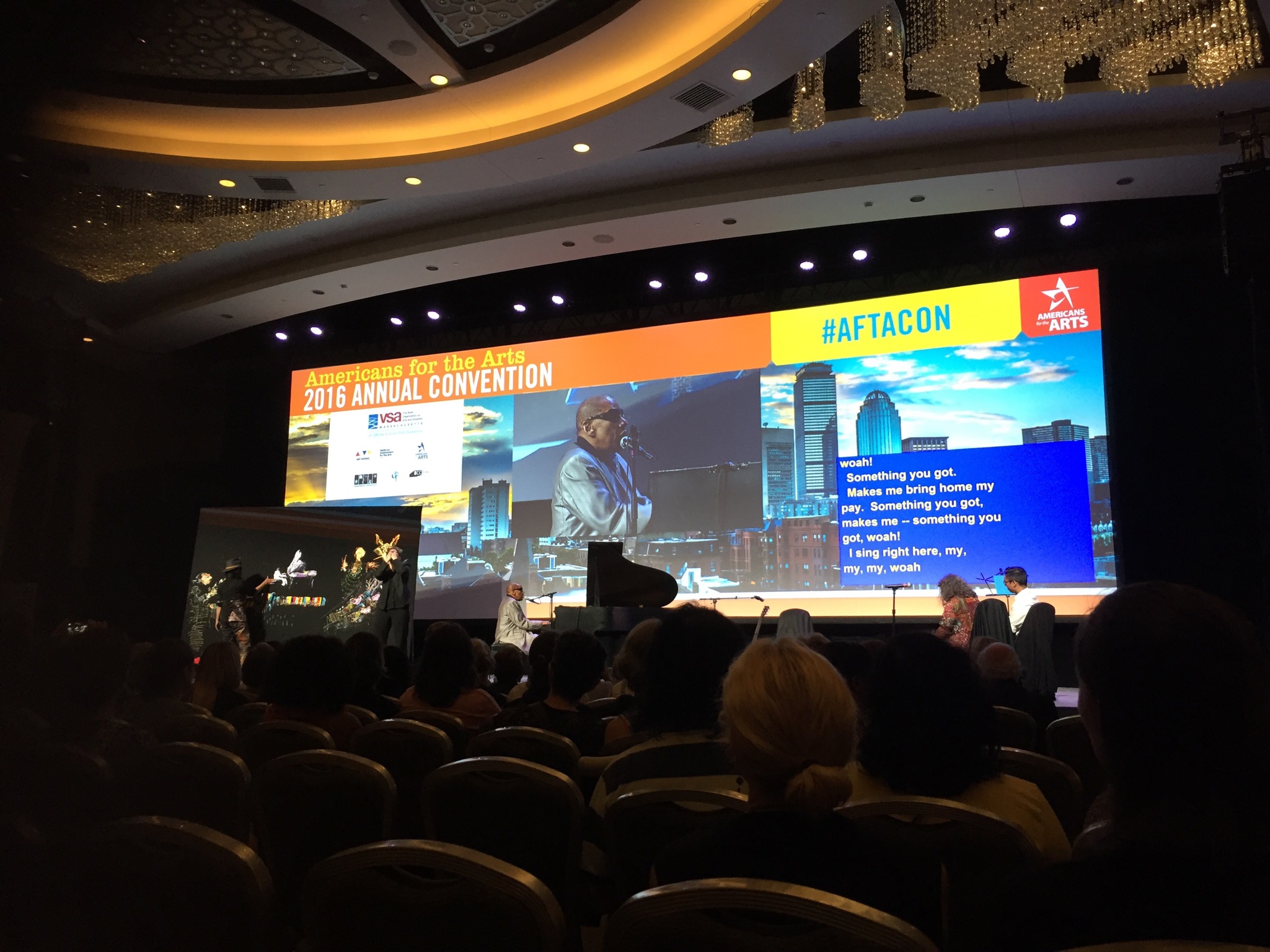 Featured simultaneous performances by musicians, painter, interpreter for the deaf (definitely interpretive dance!) and an interpreter for the blind, who narrated descriptions of what has been happening.
Featured simultaneous performances by musicians, painter, interpreter for the deaf (definitely interpretive dance!) and an interpreter for the blind, who narrated descriptions of what has been happening.
Performers were a violinist with a prosthetic right arm, a deaf poet, a blind guitar/blues harmonica player, and a blind blues/ragtime pianist, as well as the painter and two interpreters and writer.
- Consider having interpreters for the blind at events.
Sunday, 6/19 Creating the LAA for the 21st Century
- Randy Cohen, VP of Research and Policy, AFTA
- Robert Bush, president, Arts & Sciences Council of Charlotte-Medklenburg
Randy shared information from the more recent survey of LAAs – the full report is available on the AFTA web site.
He noticed:
- Names of LAAs are changing to more aspirational types of names
- 70% are non-profits, 30% are part of the city structure
- Some are embedded in Chambers of Comerce or the Community Foundations
- There are often other service agencies doing art related work.
- The label for grant making is changing to “Financing” or “Investing”
- Suggest that we follow suit and call our grants “investments,” which implies a return on investment is expected, and that value is understood.
- Most offering services like calendaring.
- Overall revenues are exceeding expenses.
In fundraising, there is much more support for specific programs: Yes, we want arts in the parks, yes we want arts ed. So use that when fundraising.
Opera in the Outfield – the opera projected one of its performances on the big screen at Washington Nationals ball stadium with hot dogs and beer, and packed the house.
Marin Alsop at the Baltimore Symphony started a Rusty Musicians orchestra and had hundreds apply to be involved – people want to make art themselves.
LAAs offer accidental collisions with the arts – putting the arts in daily life somehow, and provide gap programming.
- 28% of LAAs have a cultural plan, and where there are cultural plans, funding increases.
- Chamber of Commerce is the #1 collaborator for the field.
- Most LAAs are white, female, over 44. (WOOT we are mostly younger!)
- Important to have the diversity plan in writing.
Robert Bush
Their organization was founded in 1958 as a way to differentiate the area to attract businesses. It comes out of a United Arts Fund model, with a good old by model of 56 board members each representing a bank or other community institution.
Over the years it has changed, new Cultural Vision Plans regularly. A complete radical change in 2014 changing board membership from 56 (Originally bankers, ceos of funders and fundees, other interest groups) now 26, 4 appointed by Governor, 21 elected by Council, changing funding models and services to become more of a resource and services provider.
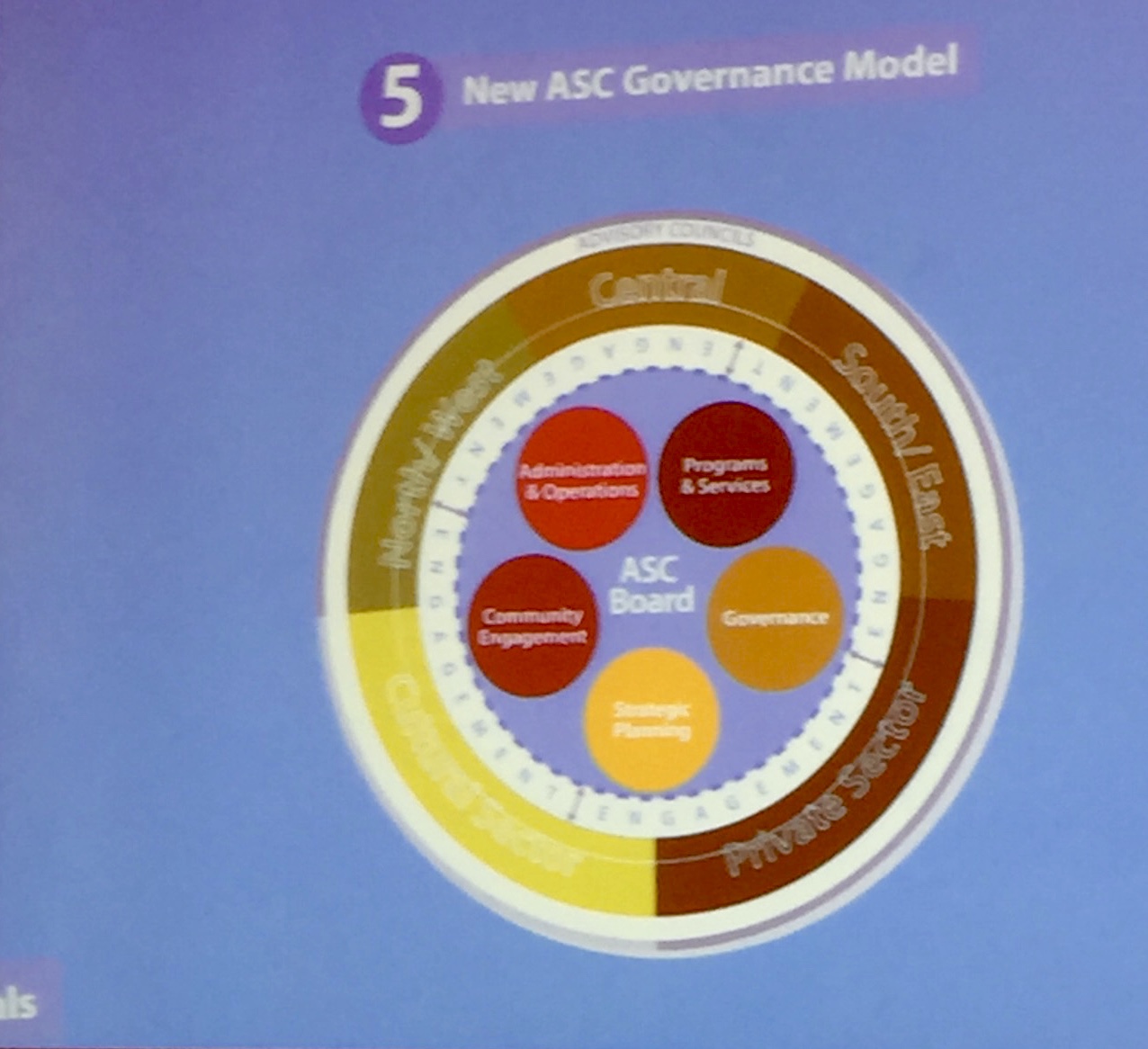 They identified core goals (programs, administration, community engagement, strategic planning, and governance) and created 5 advisory councils (regional, cultural, private, ) chaired by a member of the Council (Council members are nominated by Governance board and elected by the Council) to address and engage the community.
They identified core goals (programs, administration, community engagement, strategic planning, and governance) and created 5 advisory councils (regional, cultural, private, ) chaired by a member of the Council (Council members are nominated by Governance board and elected by the Council) to address and engage the community.
They offer operating fund support for arts, sciences, and history. They now have their grant applications reviewed by people from outside the community, and the financials reviewed specifically by CPAs.
They also refer to grants as investments. And have a cap on the amount that an organization can receive.
They offer resources, including training for young people to become board members, similar to our teaching artist training, including matching recruits to organizations. They meet monthly with regular boardsmanship type instruction (at a 4th grade level, he says), and have arts experiences – they attend art events, participate in art making. The various arts groups seeking board members present about their organizations’ work. They have a speed dating thing for organizations and prospective members to meet, and then matches are made. Graduation is at a luncheon, to highlight the accomplishments of the new board members, the organizations involved.
- Do this! Provide regular board training for people interested in joining boards. We have a serious shortage of board members for organizations. Wayne Stevens at United Way might be interested in collaborating with us – he suggests checking in with Foraker.
The organizations made it through this radical change in the organization with 35 staff by having lots of celebrations, providing time for tough conversations, going bowling, having popsicles, treating the staff as a family.
Closing Keynote
Opening entertainment by MassLeap, a youth poetry and social justice poetry slam team. (“Mom, Thank you for Wuppin’ My Butt”)
MacArthur Foundation Fellows
- Michelle Dorrance, a leading tap dance artist
- Shahzia Sekander, a Pakistani who paints from the traditional miniature tradition
Michelle: Tap is the 1st American dance form, but is not represented in dance institutions except for one school. Still considered a lesser form. She referenced Bojangles and Jimmy Slyde.
It is a combination of music and dance, and comes from an oral tradition. She collaborates with Toshi Reagan at times.
Random comment that stuck out to me: Branding is being held hostage to one idea.
Shazia’s work is now animated, and installed on large marquees. She has an exhibit opening in Italy at this moment, and in Hong Kong.
- 2017 Americans for the Arts Conference will be in June in San Francisco, which will be celebrating the 50th Anniversary of the Summer of Love. Encourage you to attend: June 16 -18, 2017
- 2018 Conference is in Denver: June 8 – 10, 2018. (Conflicts with Celebration unfortunately)
MARK YOUR CALENDARS!
